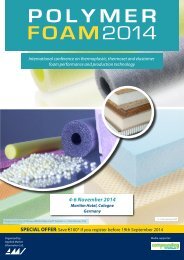Dissertations in Forestry and Natural Sciences
24lYKFN
24lYKFN
Create successful ePaper yourself
Turn your PDF publications into a flip-book with our unique Google optimized e-Paper software.
2 Wood-plastic composites<br />
By def<strong>in</strong>ition, composite materials are formed by comb<strong>in</strong><strong>in</strong>g<br />
two or more constituent materials that have substantially<br />
different chemical or physical properties (Callister 2005). As a<br />
result, the <strong>in</strong>dividual components rema<strong>in</strong> dist<strong>in</strong>ct with<strong>in</strong> the<br />
f<strong>in</strong>ished material, <strong>and</strong> thus composites can possess properties<br />
that cannot be achieved with the <strong>in</strong>dividual constituent<br />
materials. Composites can be classified <strong>in</strong>to particle-re<strong>in</strong>forced,<br />
fiber-re<strong>in</strong>forced, <strong>and</strong> structural composites. There are many<br />
well known composite materials, e.g., metal <strong>and</strong> ceramic<br />
composites, cements, concrete, <strong>and</strong> re<strong>in</strong>forced plastics.<br />
In materials science, a fiber is commonly def<strong>in</strong>ed as a<br />
substance that has been drawn <strong>in</strong>to a long <strong>and</strong> th<strong>in</strong> filament, i.e.,<br />
the aspect ratio, which is def<strong>in</strong>ed as the ratio of fiber length to<br />
diameter, is at least 100 (Callister 2005). However, the term fiber<br />
may also refer to the sp<strong>in</strong>dle-shaped cells with<strong>in</strong> the wood<br />
material (Clemons 2008), <strong>and</strong> <strong>in</strong> the case of natural fiberpolymer<br />
composites, fiber can be def<strong>in</strong>ed as an object with an<br />
aspect ratio greater than one (e.g. Stokke et al. 2014). Thus, from<br />
the viewpo<strong>in</strong>t of materials science, some WPCs can be classified<br />
as particle-re<strong>in</strong>forced composites although they are commonly<br />
referred to as fiber-re<strong>in</strong>forced composites. In this thesis, the<br />
def<strong>in</strong>ition of a fiber is adopted from the term<strong>in</strong>ology used for<br />
natural fiber-polymer composites.<br />
WPCs are fiber-re<strong>in</strong>forced composites produced by mix<strong>in</strong>g<br />
wood components <strong>and</strong> molten thermoplastics. In a WPC, a<br />
polymer forms a cont<strong>in</strong>uous matrix that surrounds the<br />
re<strong>in</strong>forc<strong>in</strong>g wood components. The low price <strong>and</strong> high stiffness<br />
of wood makes it an attractive re<strong>in</strong>forcement for the commodity<br />
plastics. S<strong>in</strong>ce the processability of WPCs is similar to the<br />
plastic, there are several appropriate manufactur<strong>in</strong>g<br />
technologies available for WPCs. Although the majority of WPC<br />
products are extruded, <strong>in</strong>jection <strong>and</strong> compression mold<strong>in</strong>g are<br />
<strong>Dissertations</strong> <strong>in</strong> <strong>Forestry</strong> <strong>and</strong> <strong>Natural</strong> <strong>Sciences</strong> No 222 23



